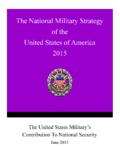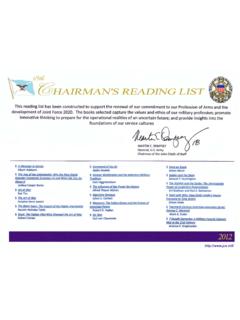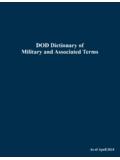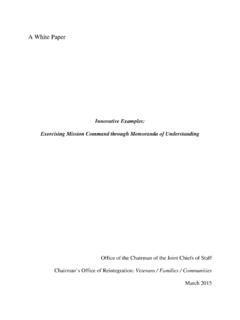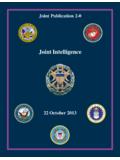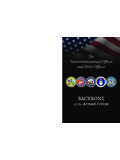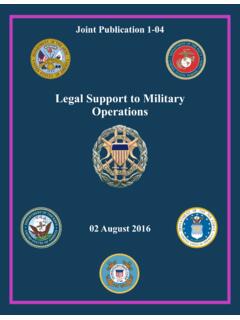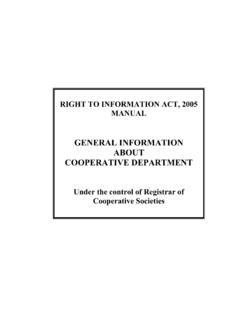Transcription of JDN 1-18, Strategy - Joint Chiefs of Staff
1 Joint Doctrine Note 1-18 Strategy25 April 2018 Unclassifiedi PREFACE 1. Scope This Joint doctrine note (JDN) provides guidance to develop, implement Strategy , and assess Strategy . It focuses on the development of national-level military Strategy and how the military instrument of power is used, in combination with the other instruments of national power, in pursuit of policy objectives. It discusses the essential elements of any Strategy ; the relationship of ends, ways, and means; and the interaction among strategic objectives, national Strategy , and military Strategy . It also examines strategies that may be developed in different situations. Finally, it looks at how Strategy is made, who makes it, what moral criteria guide strategic decisions, and what pitfalls may occur in the making of Strategy .
2 2. Purpose This JDN provides the baseline structure for understanding the fundamental principles of Strategy and provides understanding and perspective on its development, execution, and assessment that strategists, planners, trainers, commanders, and staffs can use. It provides a short-term bridging solution for Joint doctrine. The JDN supplements current Joint doctrine and provides context for those who develop national Strategy and implement it at subordinate levels. In addition to using current Joint and Service doctrine, extant procedures, and existing policy guidance, this document uses the extensive literature on Strategy found in academia, professional military education institutions, and the private sector.
3 3. Application The guidance in this JDN is not authoritative. If conflicts arise between the contents of this JDN and the contents of a Joint publication (JP), the JP will take precedence for the activities of Joint forces unless the Chairman of the Joint Chiefs of Staff issues guidance that is more current. This JDN may supplement Strategy discussions in JP 1, Doctrine for the Armed Forces of the United States; JP 3-0, Joint Operations; and JP 5-0, Joint Planning. KEVIN D. SCOTT Vice Admiral, USN Director, Joint Force Development Preface ii JDN 1-17 Intentionally Blank iii TABLE OF CONTENTS EXECUTIVE SUMMARY ..v CHAPTER I THEORY Introduction .. I-1 Overview .. I-1 Policy, Strategy , and National Power.
4 I-2 The Political Action Spectrum .. I-3 The Nature and Character of Warfare .. I-3 Levels of Strategy .. I-4 CHAPTER II STRATEGIC ENDS AND MEANS Introduction ..II-1 Analyzing the Strategic Situation ..II-3 Defining the Desired Ends ..II-3 Developing the Means ..II-5 Orchestrating the Instruments of National Power ..II-8 Adapting the Means ..II-9 Strategy s Relationship with CHAPTER III STRATEGIC WAYS Introduction .. III-1 Fundamental Strategic Approaches .. III-1 Relationship Between Strategic Ends and Military Ways .. III-3 CHAPTER IV ASSESSING Strategy Introduction .. IV-1 Continual Assessment .. IV-1 Costs and Risks .. IV-2 Assessing Validity .. IV-2 Course Corrections .. IV-3 Recognizing and Avoiding Traps.
5 IV-4 Evaluating Strategy .. IV-5 APPENDIX A Reference .. A-1 Table of Contents iv JDN 1-17 GLOSSARY Part I Abbreviations, Acronyms, and Initialisms .. GL-1 Part II Terms and Definitions .. GL-2 FIGURE I-1 Character of Warfare .. I-4 II-1 Strategic Situation ..II-2 III-1 Strategic Competition .. III-1 v EXECUTIVE SUMMARY Presents an Introduction and Overview of Strategic Theory Describes a Strategy Formulation Framework and Methodology Discusses a Fundamental Strategic Approach in Today s Complex Security Environment Explains the Value and Benefits of Continued Assessments Explains How to Determine Costs and Risks in Assessing Strategy Discusses How to Evaluate Strategy Theory Overview Strategy is about how nations use the power available to them to exercise control over people, places, things, and events to achieve objectives in accordance with their national interests and policies.
6 The challenge for the strategist is to coordinate the various levers of national power in a coherent or smart way. Joint doctrine advises, Strategy is a prudent idea or set of ideas for employing the instruments of national power in a synchronized and integrated fashion to achieve theater or multinational objectives. Ends Ways Means Risk Methodology All strategies entail the same fundamental logic of ends, ways, and means. A comprehensive and effective Strategy answers three basic questions: Where do we want to go, or what are the desired ends? How do we get there, or what are the ways? What resources are available, or what are the means? What are the risks and costs associated with the Strategy ?
7 Table of Contents vi JDN 1-17 Policy, Strategy , and National Power National Strategy orchestrates the instruments of national power in support of policy objectives and outlines a broad course of action or guidance statements adopted by the government at the national level in pursuit of national objectives. The Nature and Character of Warfare The strategist must recognize the nature of warfare and understand its implications for how to prosecute the war. The character of warfare at any point in time and in any area reflects the nature of the societies waging it. Grand Strategy Grand Strategy aims to secure and advance a nation s long-term, enduring, core interests over time. At the grand strategic level, the ways and means to achieve US core national interests are based on the national leadership s strategic vision of America s role in the world.
8 National Security Strategy The national security Strategy outlines the nation s major national security concerns and how the nation plans to deal with them. National Military Strategy The national military Strategy provides the Joint force with a framework to protect and advance US national interests. It reflects the collective wisdom of the Joint Chiefs of Staff and the combatant commanders, and represents their best military advice. Combatant Command Strategy Combatant command strategies bridge national strategic guidance and Joint operational planning as it guides the development of the Combatant Command Campaign Plan. Combatant commands develop campaign plans that outline their vision for integrating and synchronizing military activities and operations with the other instruments of national power to attain national strategic ends.
9 Executive Summary vii Strategic Ends and Means Introduction Unraveling the complexity and resolving the uncertainty calls for the ability to think strategically about the problem at hand. Thinking strategically reconciles the ends with the means and ways. The key to developing a Strategy lies in devising an ends-ways-means-risks/costs relationship that helps the strategic situation and attains the desired end state. Defining the Desired Ends A nation s interests are those fundamental, enduring conditions a state chooses to pursue. The security environment s complexity forces strategists and policy makers to make hard choices. One approach is to categorize national interests as vital, important, and peripheral.
10 Vital interests: What are we willing to die for? States generally have four vital interests: security of the home territory, safety of citizens at home and abroad, economic prosperity, and preservation of the national way of life. Important interests: What are we willing to fight for? Nations important interests generally include freedom of access to the global commons, regional stability, secure alliances, or the promotion of the state s values. Peripheral interests: What are we willing to fund (deploy peacekeepers, balance trade deficits)? The Instruments of National Power The DIME acronym (diplomatic, informational, military, and economic) has been used for many years to describe the instruments of national power.

